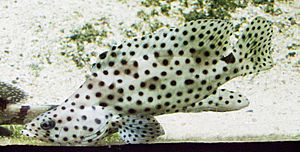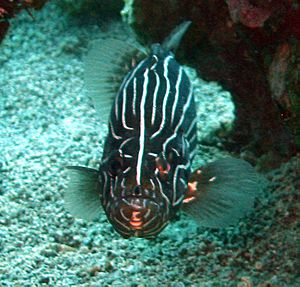Serranidae facts for kids
Quick facts for kids Serranidae |
|
|---|---|
 |
|
| Humpback grouper, Cromileptes altivelis | |
| Scientific classification |
|
| Kingdom: | Animalia |
| Phylum: | Chordata |
| Class: | Actinopterygii |
| Order: | Perciformes |
| Superfamily: | Percoidea |
| Family: | Serranidae Swainson, 1839 |
| Subfamilies | |
|
see text |
|
| Synonyms | |
|
Grammistidae Bleeker, 1857 |
|
The Serranidae are a big family of fishes. They belong to a larger group called Perciformes. This family includes about 450 different kinds of fish in 65 groups, like the well-known sea basses and groupers. While many of these fish are small (less than 10 cm long), some are huge! For example, the giant grouper is one of the biggest bony fish in the world. It can grow up to 2.7 meters long and weigh as much as 400 kg. You can find these fish in warm, tropical, and subtropical seas all over the world.
Contents
What Makes Them Special?
Many fish in the Serranidae family have bright, beautiful colors. The larger ones are often caught for food. You'll usually find them living around reefs in warm, tropical or subtropical ocean waters near coastlines.
These fish usually have a strong body shape, with big mouths and small spines on their gill covers. They also have several rows of sharp teeth. Many even have a pair of extra-large, canine-like teeth sticking out from their lower jaw.
What Do They Eat?
All serranids are carnivorous, meaning they eat other animals. Some species, especially those in the Anthiadinae group, eat only tiny floating creatures called zooplankton. But most serranids hunt and eat other fish and crustaceans (like crabs and shrimp). They are often ambush predators. This means they hide among the reef and then quickly dart out to catch any prey that swims by. Their bright colors might help them blend in, like the stripes on a tiger.
How Do They Reproduce?
Many serranid species are special because they are protogynous hermaphrodites. This means they start their lives as females and later change into males! They lay many eggs, and their tiny babies (larvae) float around in the ocean as planktonic creatures. These tiny larvae drift with the ocean currents until they are big enough to settle down and join the adult fish populations.
Tiny Hitchhikers
Like all animals, serranids can have tiny creatures called parasites living on or inside them. These can include different kinds of worms and small crustaceans. A study in New Caledonia found that serranids living on coral reefs often have about 10 different types of parasites on each fish!
Different Kinds of Serranids


Scientists are always learning new things about how fish families are related. Recent studies looking at the genes of these fish suggest that some groups, like Cromileptes and Anyperodon, might actually be part of the Epinephelus group.
The Serranidae family is divided into several main subfamilies and tribes:
- Subfamily Anthiinae Poey, 1861
- Subfamily Epinephelinae Bleeker, 1874 (groupers)
- Tribe Niphonini D.S. Jordan, 1923
- Tribe Epinephilini Bleeker, 1874
- Tribe Diploprionini Bleeker, 1874
- Tribe Liopropomini Poey, 1867
- Tribe Grammistini Bleeker, 1857
- Subfamily Serraninae Swainson, 1839
- incertae sedis
- †Palaeoperca Micklich, 1978 (found as a fossil in Germany from the Eocene period)
Timeline of Genera

This timeline shows when different groups (genera) of Serranidae fish first appeared on Earth. It goes back millions of years!
See also
 In Spanish: Serranidae para niños
In Spanish: Serranidae para niños


